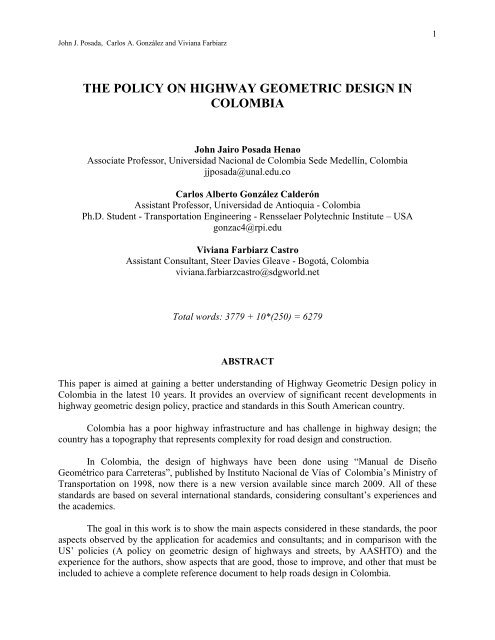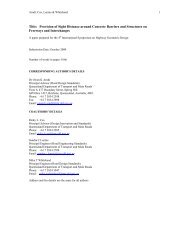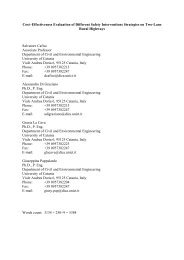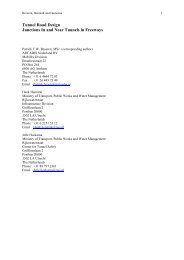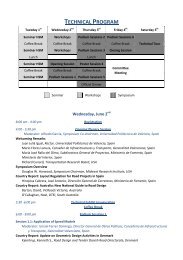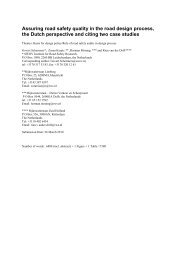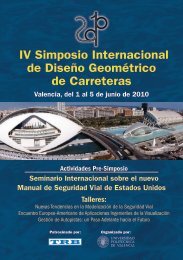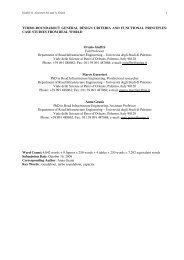THE POLICY ON HIGHWAY GEOMETRIC DESIGN IN COLOMBIA
THE POLICY ON HIGHWAY GEOMETRIC DESIGN IN COLOMBIA
THE POLICY ON HIGHWAY GEOMETRIC DESIGN IN COLOMBIA
You also want an ePaper? Increase the reach of your titles
YUMPU automatically turns print PDFs into web optimized ePapers that Google loves.
John J. Posada, Carlos A. González and Viviana Farbiarz<br />
1<br />
<strong>THE</strong> <strong>POLICY</strong> <strong>ON</strong> <strong>HIGHWAY</strong> <strong>GEOMETRIC</strong> <strong>DESIGN</strong> <strong>IN</strong><br />
<strong>COLOMBIA</strong><br />
John Jairo Posada Henao<br />
Associate Professor, Universidad Nacional de Colombia Sede Medellín, Colombia<br />
jjposada@unal.edu.co<br />
Carlos Alberto González Calderón<br />
Assistant Professor, Universidad de Antioquia - Colombia<br />
Ph.D. Student - Transportation Engineering - Rensselaer Polytechnic Institute – USA<br />
gonzac4@rpi.edu<br />
Viviana Farbiarz Castro<br />
Assistant Consultant, Steer Davies Gleave - Bogotá, Colombia<br />
viviana.farbiarzcastro@sdgworld.net<br />
Total words: 3779 + 10*(250) = 6279<br />
ABSTRACT<br />
This paper is aimed at gaining a better understanding of Highway Geometric Design policy in<br />
Colombia in the latest 10 years. It provides an overview of significant recent developments in<br />
highway geometric design policy, practice and standards in this South American country.<br />
Colombia has a poor highway infrastructure and has challenge in highway design; the<br />
country has a topography that represents complexity for road design and construction.<br />
In Colombia, the design of highways have been done using “Manual de Diseño<br />
Geométrico para Carreteras”, published by Instituto Nacional de Vías of Colombia’s Ministry of<br />
Transportation on 1998, now there is a new version available since march 2009. All of these<br />
standards are based on several international standards, considering consultant’s experiences and<br />
the academics.<br />
The goal in this work is to show the main aspects considered in these standards, the poor<br />
aspects observed by the application for academics and consultants; and in comparison with the<br />
US’ policies (A policy on geometric design of highways and streets, by AASHTO) and the<br />
experience for the authors, show aspects that are good, those to improve, and other that must be<br />
included to achieve a complete reference document to help roads design in Colombia.
John J. Posada, Carlos A. González and Viviana Farbiarz<br />
2<br />
1. <strong>COLOMBIA</strong>N STANDARDS FOR <strong>GEOMETRIC</strong> <strong>DESIGN</strong> OF <strong>HIGHWAY</strong>S<br />
A manual on highway geometric design should establish the criteria and the correct procedure to<br />
create a proper design that satisfies the needs of the roadway users. Some of the most important<br />
aspects to consider are listed below:<br />
• Safety of roadway users.<br />
• Proper level of service.<br />
• Economic efficiency for the users of the roadway system.<br />
• Economic efficiency in construction and maintenance costs.<br />
• Aesthetics and landscaping factors.<br />
• Environmental friendliness in the design.<br />
Regulations of highway geometric design have existed in Colombia since early 1970. This were<br />
defined for the national territory by government agencies, first by the Ministry of Public Works<br />
(1970) and latter by the Ministry of Transportation (1998 and 2008). The covers for each of the<br />
issued regulations are shown in FIGURE 1. The latest version was issued by the Ministry of<br />
Transportation in 2009 and is applicable starting March of the same year.<br />
Applicable since 1970 Applicable since 1998 Applicable since 2009<br />
FIGURE 1 Covers of Issued Regulations for Highway Geometric Design in Colombia, from 1970 to 2008.<br />
Additionally, local governments create standards that regulate roads within their<br />
jurisdiction. For example, FIGURE 2 illustrates the standards created by the government of<br />
Antioquia in 1986, which specifies the standards for highway geometric design within the region<br />
of Antioquia in Medellin, Colombia.
John J. Posada, Carlos A. González and Viviana Farbiarz<br />
3<br />
FIGURE 2 Cover for Issued Standards for Highway Geometric Design for Antioquia – Colombia.<br />
2. C<strong>ON</strong>CEPTS AND C<strong>ON</strong>TENTS OF <strong>COLOMBIA</strong>N STANDARDS FOR <strong>HIGHWAY</strong><br />
<strong>GEOMETRIC</strong> <strong>DESIGN</strong><br />
The standards previously mentioned have been adapted from standards of other countries,<br />
particularly the United States. This has occurred mainly due to the scarce research that has been<br />
developed in the field of highway design in Colombia. A description of standards issued is<br />
presented in the following sections.<br />
2.1 Colombian Standard for Highway Geometric Design of 1970<br />
These standards are usually referred to as “Criterio geométrico para diseño de carreteras”. This<br />
specify that the guidelines presented are economically efficient within the limitations required by<br />
the estimated Annual Daily Traffic (ADT), the topography, and the requirements established by<br />
safety parameters that need to be provided to the users. These criteria were based on the<br />
estimated volume and capacity provided by the Highway Capacity Manual of 1965. The standard<br />
is a key element to ensure the quality of the project during the life cycle it will endure.<br />
The standard was created to satisfy the need to standardize and regulate the design<br />
practice. The development of the guidelines highlight the importance of the planning process, the<br />
return of investment, the reduction of accidents and the need to supply the changing demand.<br />
The normative uses traffic and topography as the main inputs. These establish the foundation for<br />
the classification of the proposed highway, defining a classification index to implement the basic<br />
design parameters. The parameters are defined for the highway horizontal design, the vertical<br />
design or profile, and the design of cross-section. These elements are design to warrant safety,<br />
comfort, esthetics, and the harmony between the different factors that need to be taken into<br />
account.
John J. Posada, Carlos A. González and Viviana Farbiarz<br />
4<br />
The objective of the standard is to define a speed that ensures the economic efficiency of<br />
the operational costs, especially considering the effect that heavy vehicle have on this costs. The<br />
content of the standard is as follows:<br />
Chapter 1. Introduction<br />
Chapter 2. Controls and Design Criteria<br />
Chapter 3. Elements of Design<br />
Chapter 4. Cross-Section Elements of Highways<br />
Moreover, the standard accounts for bicyclists where there is a volume of 500 bicyclist<br />
and 2000 vehicles, and during the peak hour. Similarly, the use of circulation lanes for heavy<br />
vehicles (climbing lanes) is considered whenever the longitudinal slopes requires it, and the<br />
traffic volume is larger than 1000 vehicles per day.<br />
Furthermore, limitation for spiral transition and super-elevation are specified. The<br />
standard establishes 10% for the maximum super-elevation in cross-sections, and requires the<br />
use of transition curves is optional. Recommendations are made to use the spiral curve of Euler,<br />
in order to account for a better and smoother transition. The design of intersections is not part of<br />
the standards created.<br />
The Colombian standard establishes the minimum values to be considered for the<br />
different parameters, and explains each of the criteria employed in the development of these<br />
parameters. The minimum values are summarized in FIGURE 3 and FIGURE 4 presented below.<br />
FIGURE 3 Minimum requirements for highway geometric design – Standard of 1970.
John J. Posada, Carlos A. González and Viviana Farbiarz<br />
5<br />
FIGURE 4 Minimum requirements for highway improvements – Standard of 1970.<br />
2.2 Colombian Standard for Highway Geometric Design of 1998<br />
The National Institute of Highways (Instituto Nacional de Vías) is a branch of the Ministry of<br />
Transportation, which is in charge of the creation of policies related to roadway infrastructure<br />
and the transportation network. This agency supplies the standards and regulations for highway<br />
geometric design according to the changes in the demand and the number of vehicles. This was<br />
created to provide practitioners with an everyday guide that can be used in the design practice.<br />
In the last couple of years the quality of the standards has had to increase due to the<br />
global changes in the number and type of vehicles. Changes in horsepower, speed and comfort<br />
have imposed the need of better roads prepared through the design. Additionally, the growing<br />
need of more sustainable roads that ensure safety and account for environmental factors have<br />
also increased the requirements for new roads to come.<br />
On the other hand, the understanding of the human behavior has increased from 1970 to<br />
the date. This has made several countries to adjust the standards to account for human factors.<br />
The document, usually referred as “Manual de diseño geométrico para carreteras” was<br />
published in 1998. This standard regulates all highways within the Colombian country. The<br />
objectives of the standard are defined as follows:<br />
• Unify the design process<br />
• Provide the users of the system with a safe and comfortable environment that is also<br />
functional, integral, efficient, esthetic, and environmentally friendly.
John J. Posada, Carlos A. González and Viviana Farbiarz<br />
6<br />
The standard establishes the complete design process, from the conception of the project<br />
to the practice and procedure that need to be followed. Additionally, the standard defines and<br />
classifies highways and projects to ensure a proper treatment in the design process. A complete<br />
chapter is dedicated to the planning of the highway project.<br />
The design process is considered the most important element of the highway project. This<br />
establishes the factors that define the final configuration for the design, maximizing the<br />
fundamental objectives. These are functionality, safety, comfort, aesthetics, economic efficiency,<br />
and environmental friendliness.<br />
The factors can be grouped in external or previously existing factors, and internals. The<br />
external factors are related with the topography, geologic and geotechnical considerations, traffic<br />
volume for the base and future year, environmental factors, climate and hydrology parameters,<br />
existing and new urban development and land use, and the socioeconomic parameters of the<br />
affected region. All this information is basic and previous at the beginning of the geometric<br />
design. Therefore, early efforts have to be made to compile and extract all the necessary data, in<br />
order to perform further analysis and establish the parameters that will define the final selected<br />
design. The internal factors consider the target speed for the final selected design. This is done<br />
by considering the operational issues that would encounter one geometric layout in comparison<br />
with another specially when considering the safety and the sustainability of the highway.<br />
This document compiles the standard and regulations needed to design a highway project.<br />
The different chapters contain the general design criteria, and the requirements needed for the<br />
horizontal and vertical alignment, the cross-sectional elements, and the other elements that need<br />
to be considered. The standard ensures the integration of these parts. Additional chapters provide<br />
the criteria for the application and design of intersections, bridge structures, tunnels, intersection<br />
with urban and suburban areas, landscaping and elements of highway quality. Some topics that<br />
are related to the design are not included, such as: overpasses, braking ramps, lane changing<br />
lanes, safety barriers, bicycle roads, among others.<br />
Several classifications are presented in the manual; however, most of the guidelines are<br />
defined for two-way highways. The definition of parameters for multi-lane roads, intersections<br />
and urban roads are only approach in a superficial manner. The following chapters describe the<br />
content of the Colombian standard of 1998:<br />
• Presentation<br />
• Prologue<br />
• Introduction<br />
• Philosophy<br />
• Procedure<br />
• Chapter 1. Highways<br />
• Chapter 2. Planning<br />
• Chapter 3. Design Criteria<br />
• Chapter 4. Quality in Highway Geometric Design<br />
• Chapter 5. Technical Information
John J. Posada, Carlos A. González and Viviana Farbiarz<br />
7<br />
Some chapters approach intersection design, and special lanes for heavy vehicles and<br />
bicycles. However, this is not described in too much detail given the limitations.<br />
The Colombian standard uses speed as the primary parameter to consider in the design. In<br />
the last couple of years the main change has been in the adopted speed. The standard of 1998<br />
required the use of specific speed rather than the traditional design speed, in order to establish<br />
the turning radii, superelevation and sight distance for the vehicle maneuvers.<br />
The design speeds regulate the different speed ranges along the highway. When designing<br />
with different specific speeds, the safety and comfort will be maintain throughout each element<br />
in the highway. For example, establishing the superelevation of a curve with the specific speed<br />
rather than the design speed, will maintain a lower value. Even if the design speed continues<br />
being a basic parameters, interesting insights can be gathered through the selection and<br />
application process, this can be obtain using the drivers behavior and providing a speed that<br />
satisfies the user needs. Taking into account that users assume different speed with the type of<br />
roadway that their using, and according to the topographic parameters, and urban environment,<br />
different design speeds can be assumed. TABLE 1 presents a set of speeds that can be provided<br />
to accommodate the users to a more “realistic” speed that is also safe and comfortable.<br />
TABLE 1 Design Speeds according to roadway type and topography – Colombian Standard 1998<br />
Moreover, to ensure the proper circulation of vehicles and the stability along the curves, a<br />
turning radius is provided with a super-elevation on the outer side of the curve. The<br />
superelevation is used to warrant the safety operation of the horizontal curves. This is done to<br />
oppose the centrifuge force that tends to unbalance the vehicle and force it out of the roadway.<br />
The superelevation overcomes this force inclining the cross-section of the pavement to ensure<br />
the proper friction between the tires and the pavement. For the Colombian standard a maximum<br />
superelevation of 8% is provided for speeds inferior or equal to 70km/h (turning radius of 170m),<br />
and it gradually changes its value as the speed and turning radius increase.<br />
TABLE 2 presents the values adopted by the standard for the specification of the<br />
superelevation and the design speed.
John J. Posada, Carlos A. González and Viviana Farbiarz<br />
8<br />
TABLE 2 Minimum turning radius – Colombian standard 1998<br />
For the horizontal alignment, transition curves should be provided. The standard recommends the<br />
use of Euler’s Spiral, also known as arc of radius, which objective is to smooth the<br />
discontinuities of the curve and the superelevation to improve safety and comfort. This technique<br />
allows to avoid the abrupt change of the radial acceleration, enabling appropriate distances that<br />
provide a better operation of the curve.<br />
Furthermore, the appropriate classification of roads is needed to ensure the transition of<br />
different highway speeds. An appropriate distance is needed to ensure that the characteristics of<br />
each section of the highway are perceived by the user. The norm establishes that a minimum of<br />
2km distances should be provided for the perception process to be accomplished. Here, the driver<br />
familiarizes with the new section and the environment that surrounds the road. This ensures a<br />
progressive transition of speeds that follow the pre-specified design speed. This will also allow a<br />
smoother transition between speeds. For this, the standard also regulates a maximum speed<br />
change of 20 km/h between two different highway sections.<br />
The Colombian standard also ensures that the professional opinions are taken into<br />
account. This specifies that the results of the described procedures should not overrule the<br />
professional judgment made by the practitioner. The procedure should only serve as a source of<br />
information that creates the preliminary foundation of the design.<br />
2.3 Colombian Standard for Highway Geometric Design of 2008<br />
The standards defined for 2008, usually referred as “Manual de Diseño Geométrico de<br />
Carreteras”. This was officially adopted as a technical standard for projects in the national<br />
roadway network in March of 2009. This was done under the order 0744 of the Ministry of<br />
Transportation.
John J. Posada, Carlos A. González and Viviana Farbiarz<br />
9<br />
The 2008 manual was adjusted using the standards developed by AASHTO in 2004. This<br />
is intended to summarize in a coherent manner the criteria adopted for highway geometric design<br />
in the recent years. This is done by establishing parameters that warrant the consistency of the<br />
elements, unifying the design procedure and documentation needed to develop a highway<br />
project, according to their type and level of detail.<br />
The criteria described in the manual correspond to the systematization of the experiences<br />
gathered from Colombia and other nations, expressed in data gathered through the years. Under<br />
no circumstances this is intended as an academic material that replaces the application of<br />
knowledge in the field. In some particular cases it may not be possible to perform the prespecified<br />
values; engineering judgment will have to be made by the responsible of the project.<br />
Changes that don’t affect the safety and comfort of the users, and do not present any exceeding<br />
resources will be accepted.<br />
For this manual, the primary element to be considered is the consistency of the geometric<br />
design. This is an important criterion, given that none of the previously issued manuals<br />
accounted for consistency in the design. This ensures a safe speed between designs that warrant<br />
the safety of the users.<br />
The content of this standard is described by the following chapters:<br />
• Chapter 1. General Aspects<br />
• Chapter 2. Controls for Geometric Design.<br />
• Chapter 3. Horizontal Alignment of Highway Axis.<br />
• Chapter 4. Vertical Alignment of Highway Axis.<br />
• Chapter 5. Cross-Section Design of Highway<br />
• Chapter 6. Overpasses and Underpasses<br />
• Chapter 7. Geometric Design of Special Cases<br />
• Chapter 8. Consistency along the Highway Geometric Design.<br />
• Chapter 9. Assuring Quality of Design<br />
• Glossary<br />
Similar to the 1998 standards, this standard guides the designer in the selection of the<br />
design speed according to the roadway category and the type of topography or surface. As it can<br />
be seen in TABLE 3; is possible to identify the differences established among the ranges in<br />
TABLES 2 and 3.<br />
This standard allows the design of the horizontal curve by matching the radius that better<br />
fits the topography, assigning the correct super-elevation without modifying the specific speed,<br />
which was assign for consistency. This way the conditions can be improved for the user without<br />
affecting the consistency of the design. The same super-elevation of 8% is maintained for<br />
primary and secondary roadways, as was in the previous manual of 1998. For the third degree<br />
roads a maximum super-elevation of 6% is specified to facilitate the transition between short<br />
segments in the horizontal alignment. This case is typical in mountain roads that have short<br />
segments due to high slopes. The friction factors have been modified and are specified in the<br />
table below (see TABLE 4).
John J. Posada, Carlos A. González and Viviana Farbiarz<br />
10<br />
TABLE 3 Design Speed according to type of highway and surface – Colombian Standards 2008<br />
TABLE 4 Friction factors for cross-sections<br />
Velocidad (km/h) 30 40 50 60 70 80 90 100 110 120 130<br />
Manual 1998 0,180 0,172 0,164 0,157 0,149 0,141 0,133 0,126 0,118 0,110 0,100<br />
Manual 2008 0,280 0,230 0,190 0,170 0,150 0,140 0,130 0,120 0,110 0,090 0,080<br />
The minimum radius is estimated according to the specified friction factors, these are associated<br />
with the different design speeds. The values are shown in TABLE 5 and TABLE 6 for primary<br />
and secondary roads, and third degree roads, respectively.<br />
TABLE 5 Minimum turning radius for 8% super-elevation (primary and secondary roads) – Colombian<br />
standards 2008<br />
TABLE 6 Minimum turning radius for 6% super-elevation (third degree roads) – Colombian standards 2008
John J. Posada, Carlos A. González and Viviana Farbiarz<br />
11<br />
As defined in the former manual of 1998, the development of the super-elevation should<br />
only be done in the tangent prior to the curve. Only under exceptional circumstances, the<br />
standard allows between 20% and 40% to be developed within the curves. However, in this<br />
edition (2008), at least in the third part of the curve the super-elevation is required; this provides<br />
an additional safety factor for the users.<br />
Additionally, this manual contains software called “Curvas” (Curves). This allows the<br />
mathematical calculation of the different types of horizontal curves and the linkages with the<br />
tangents and vertical curves. Some example models are presented to illustrate and guide the<br />
practitioner through the design.<br />
Throughout the standard, the concept of section design in maintained. However, the<br />
length of the sections has been modified and updated. To establish homogeneity between<br />
sections and establish their design speed, the following criteria should be considered:<br />
• The minimum length of each section of highway with a specified design speed should be<br />
greater tan 3Km for speeds between 20 and 50 km/h, and 4km for speed between 60 and<br />
110 Km/h.<br />
• The difference of speed between sections should not exceed 20km/h.<br />
However, if a distance is needed that is shorter than the specified; a speed difference of<br />
less than 10 km/h should be specified.<br />
Other requirements of speed ensure that the specific speed of any homogeny section<br />
should be equal or less than the design speed of the section. Additionally, the sections should<br />
never be more tan 20km/h of difference of speed.<br />
The perception-reaction time is of 2.5 seconds, which is greater than the time considered<br />
by the 1998 standard, which was 2.0 seconds. This provides an additional safety feature for the<br />
users.<br />
Some differences are also present in this manual in comparison with previous issues. In<br />
this version of the standard the vertical alignment is better defined. The evolution of the slope is<br />
done by considering the median slope and the maximum slope of the tangent, while in previous<br />
versions only the maximum slope was considered. This defines the critical length of the tangent.<br />
The cross-section now includes an analysis of the additional width provided whenever the design<br />
vehicle is a truck type of vehicle. The minimum width defined for the lane was increased to 6<br />
meters. Some other geometric widths were modified to adjust the development of new vehicle<br />
sizes, particularly trucks. The specification of intersections still has very little attention in this<br />
manual, and the practitioners are referred to foreign manual to approach the design of this<br />
element whenever an urban highway is being designed.<br />
3. C<strong>ON</strong>CLUSI<strong>ON</strong>S AND RECOMMENDATI<strong>ON</strong>S<br />
In the last 40 years there have been three design standards developed in Colombia, from<br />
the first issued in 1970. These documents have had reasons for their existence and application.
John J. Posada, Carlos A. González and Viviana Farbiarz<br />
12<br />
Several improvements have been observed and executed, ensuring better quality in the design<br />
process that increases the safety of the users.<br />
Some differences were observed when comparing different issues. The standard of 1970<br />
presents an appropriate summary of the requirements for geometric design of highways.<br />
However, in the following issues (1998 and 2008) no summary is presented. Each manual<br />
considered safety as the primary design objective; later specify the design parameters for each of<br />
the elements. However, some of these considerations are not the same for different issues. In the<br />
1970 standard the traffic volume is considered for the definition of the design speed. On the<br />
other hand, posterior issues (1998 and 2008) consider the topography and type of highway to<br />
define the design speed. Therefore, some measures should be taken in order to ensure the<br />
consistency between issues, following the changes of technological advances gathered through<br />
the years.<br />
A common feature between standards is the use of foreign resources. All of the<br />
Colombian standard issues have been supported by standards developed in other countries. This<br />
needs to be improved through the creation of research projects that resemble the characteristics<br />
of the region, considering several of the elements, such as: friction factors, design vehicles,<br />
topography, among others. This will enhance the understanding of the design, and will provide<br />
better fit layouts for future projects.<br />
The development of research projects will improve the standards of geometric design in<br />
Colombia. This will benefit society by providing more comfortable and safe roads. This has been<br />
previously proven in the creation of the “Manual de Capacidad y Niveles de servicio para<br />
Carreteras de dos carriles”, which gives the guidelines to evaluate the capacity and level of<br />
service for two lane roads. This manual set Colombia as one of the only countries that developed<br />
their own methodology for the evaluation of those parameters for this type of road infrastructure.<br />
A similar manual is being created for multi-lane roads. Therefore, the development of new<br />
standards through research will promote the better design practices adjusted to the regional<br />
issues that define the Colombia’s roadway network.<br />
6. REFERENCES<br />
• American Association of State Highway and Transportation – AASHTO - (2004). A<br />
Policy on Geometric Design of Highways and Streets, USA.<br />
• Ministerio de Obras Públicas. (1970). Criterio Geométrico para Diseño de Carreteras,<br />
Colombia.<br />
• Ministerio de Transporte. (1998). Manual de Diseño Geométrico para Carreteras,<br />
Colombia.<br />
• Ministerio de Transporte. (2008). Manual de diseño Geométrico de Carreteras, Colombia.<br />
• Ministerio de Transporte. (2009). Resolución 0744, Colombia.


